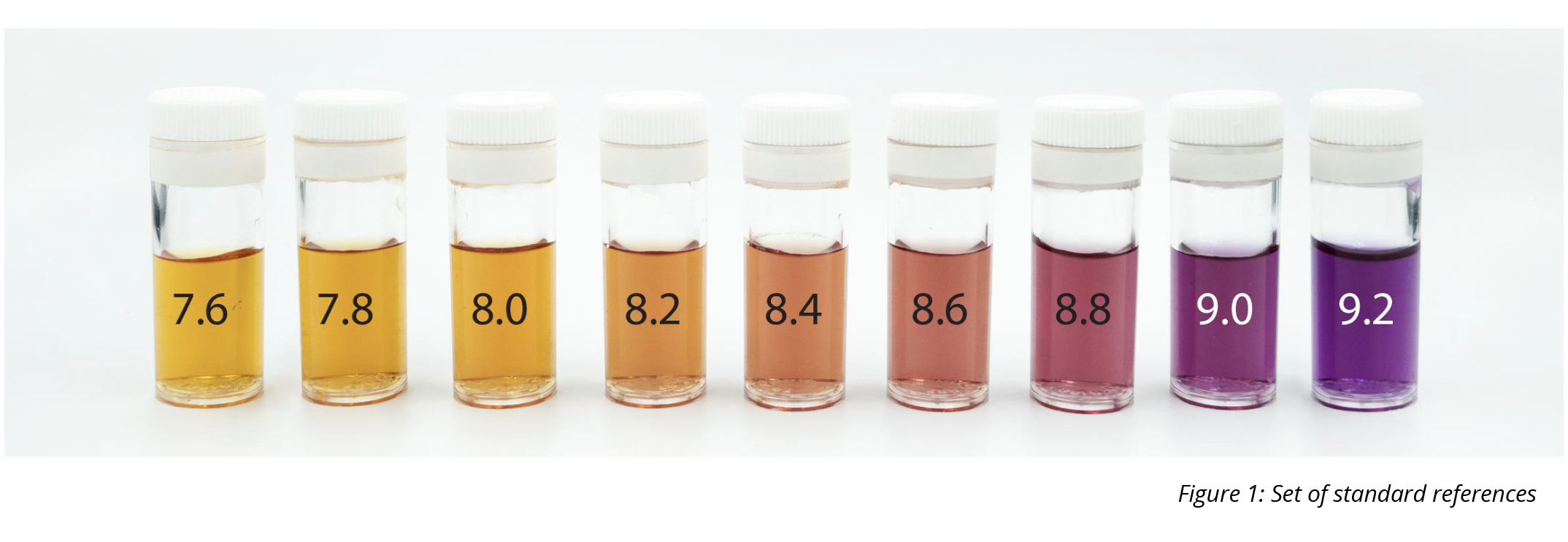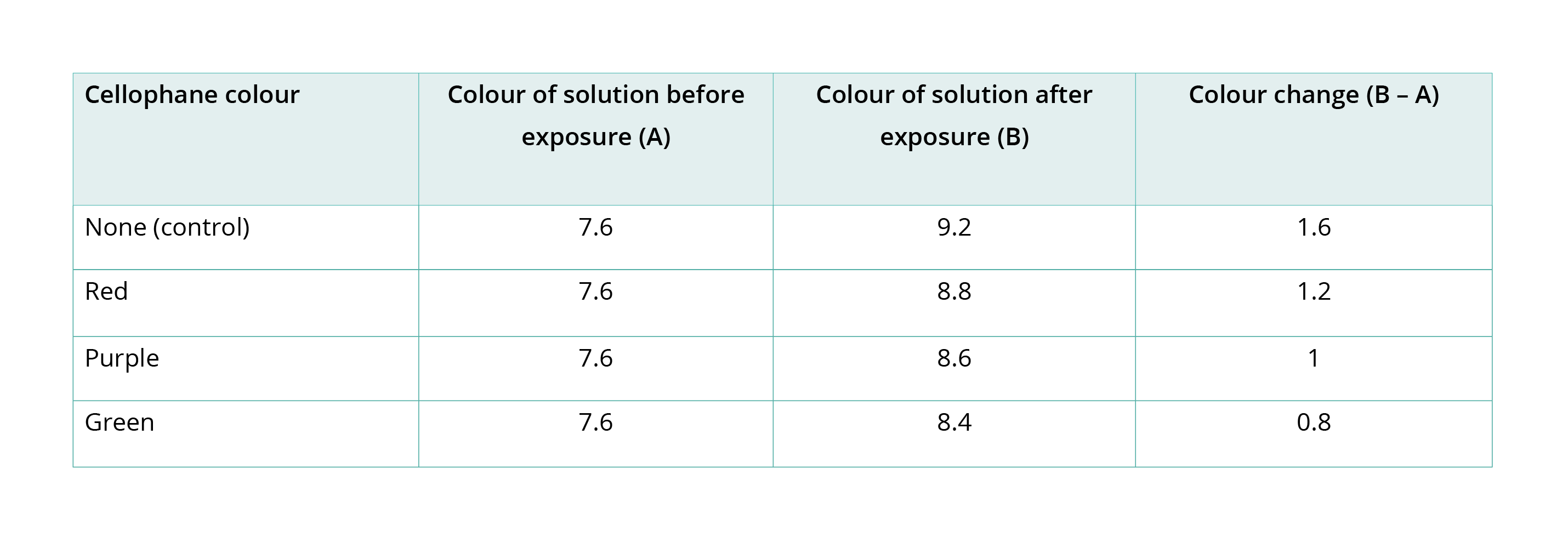Light wavelength and photosynthesis

AUSTRALIAN CURRICULUM ALIGNMENT:
-
In eukaryotic cells, specialised organelles facilitate biochemical processes of photosynthesis, cellular respiration, the synthesis of complex molecules (including carbohydrates, proteins, lipids and other biomacromolecules), and the removal of cellular products and wastes (ACSBL049)
- Cells require inputs of suitable forms of energy, including light energy or chemical energy in complex molecules, and matter, including gases, simple nutrients, ions, and removal of wastes, to survive (ACSBL044)
- The cell membrane separates the cell from its surroundings and controls the exchange of materials, including gases, nutrients and wastes, between the cell and its environment (ACSBL045)
- Photosynthesis is a biochemical process that in plant cells occurs in the chloroplast and that uses light energy to synthesise organic compounds; the overall process can be represented as a balanced chemical equation (ACSBL052)
BACKGROUND:
During photosynthesis, radiant energy is converted into organic substances that can be stored within the plant to support growth, reproduction, and metabolism. Plants metabolise the sugars that form as a result of sunlight, Carbon Dioxide, and water reacting. Reliably studying photosynthesis first hand can be difficult and require precise setting up. Algal ball photosynthesis kits offer an easier, more accurate method of studying photosynthesis that is perfect for use within the classroom. Algal balls are stored in small vials filled with Hydrogen Carbonate indicator solution. When exposed to light, the encapsulated algae absorb the CO2 from the solution they are stored in during the process of photosynthesis. As a result of the lowered CO2 levels, the pH of the solution will rise. When no light is available, respiration will dominate and the pH will decrease through the release of CO2. Changes in the levels of carbonic acid can be monitored via the colour changes that occur due to the hydrogen carbonate indicator.In this practical, students have the opportunity to tangibly observe photosynthesis. They are tasked with observing how the colour changes from yellow/orange to purple when the algal balls and solution are placed under a light source as photosynthesis takes up dissolved CO2 and the pH rises. Students create a light filter to test whether the wavelength of light affects the photosynthetic rate of the algae. This is a great practical to introduce students to the basic principles of photosynthesis in a fun, simple and interactive way.
PREPARATION- LAB TECHNICIAN
Algal Ball Culture Care
-
The algal balls will arrive stored in a container of distilled water. Remove the algal ball container from its packaging as soon as it arrives and loosen the lid to allow for airflow.
- The Chlorella within the balls is alive and therefore needs light to stay active. We recommend that you leave the balls in the container that they arrive in, and that you place this vial in a well-lit area until required. Do not place in direct sunlight or expose them to too much heat.
- Use the algal balls as early as you can; otherwise, they are best used within 2 weeks.
- If you wish to make your own algal balls, visit our helpful ‘How to make Algal Balls’ resource on our website.
General Preparation
-
If you are using a 10x concentrate hydrogen carbonate indicator, add 10 mL of the indicator to 90mL of distilled water to dilute.
- Rinse the vials for your experiment using hydrogen carbonate indicator solution. To do this, add approximately 1mL of hydrogen carbonate indicator solution to a vial, replace the cap on the vial and shake.
- Next, pour the rinse liquid into the second vial and repeat until you have rinsed all required vials. Discard the rinse liquid from the last vial.
METHOD-STUDENT ACTIVITY
- Separate the algal balls from the surrounding liquid using the strainer. To do this, pour the algal balls into a strainer over a small beaker.
- Use the spoon to place an equal number of balls into each vial.
- Using a plastic pipette, fill all the vials with the hydrogen carbonate indicator. Make sure the caps are secured.
- Keep one vial to act as your control.
- Wrap a different piece of coloured cellophane around the other three vials.
- Place each vial approximately 10 cm away from your light source. Make sure the vials do not get hot.
- Copy the results table into your logbook and complete column A by comparing the colour of the hydrogen carbonate indicator to the set of pH standard solutions. You can use the image below (Figure 1) as a guide if standards are not available, however comparing the colour of the liquid in your vials to actual pH standard solutions will provide the most accurate results.
- After 40 minutes complete column B of the results table by comparing the colour of the hydrogen carbonate indicator to the set of standard references.
- Complete the final column of the results table by subtracting the amount in column A from the amount in column B.

OBSERVATION AND RESULTS
After exposing the vial to a light source, the colour in the solution should change from yellow/orange to purple as photosynthesis absorbs the CO2 and the pH rises. The pH of vials wrapped red, blue or purple cellophane will experience a greater rise than vials wrapped orange, yellow or green. This is due to the way the algae absorb light - we observe them as green because that is the colour that bounces off them out of the spectrum that makes up white light and so that is the colour that is not used in photosynthesis. Some change should be expected by the end of the class, however if it is too slight to notice you can return at the end of the day or the next day to check your vials.

INVESTIGATION
- Carbon dioxide dissolved in water forms carbonic acid. Hydrogen carbonate indicator is used to measure the acidity of a system. The pH of the system is low (yellow) when there is a lot of dissolved CO2. As CO2 is removed, the pH rises and the colour becomes purple. Use this information to construct a bar graph of CO2 changes as a function of wavelength.
- Why do we include a control in the experiment? What does this control represent in term of light wavelength?
- The control represents all of the wavelengths of light, as it is not obscured by a colour filter. This control is used to compare the level of photosynthesis that takes place in the vials. All three vials are placed under the same conditions, to see whether the colour filters slow down photosynthesis or block usable wavelengths entirely.
- Describe the process that is happening in the vials with regards to photosynthesis and respiration.
- Both photosynthesis and respiration are happening all of the time, with photosynthesis dominating when light is available and respiration dominating in the absence of light. During photosynthesis, carbon dioxide and water plus the energy from light synthesise glucose and oxygen. As carbon dioxide is used up, carbonic acid in the water is converted to carbon dioxide, raising the pH of the water.
- During respiration, glucose is broken down along with oxygen to make carbon dioxide and water. As carbon dioxide enters the water, excess molecules are converted to carbonic acid, lowering the pH of the water.
EXTENSION EXERCISE
- Light availability is another factor that affects photosynthesis. Design an experiment to test how distance from light effects the rate of photosynthesis.
TEACHER TIP
If you are providing students with the already prepared 7mL vials with the algal balls and indicator, it may be a good idea to expose them to light for half an hour or so beforehand to start photosynthesis. If there is no change by the end of the class, your students can come back at the end of the day or the following day to observe the colour change.
 Time Requirements
Time Requirements
- 90 mins
 Material List
Material List
- Algal Ball Photosynthesis Individual Kit
- Algal Ball Photosynthesis 8 Station Value Kit
- or
- 60 algal balls
- 4 × 7 mL empty dram vials
- 40 mL (approx.) hydrogen carbonate indicator
- Plastic pipette
- and
- Light source
- Set of pH standards or colour chart
- Red, purple and green cellophane
- Strainer
- Spoon
- Disposable gloves (optional)
 Safety Requirements
Safety Requirements
- Wear appropriate personal protective equipment (PPE).
- Know and follow all regulatory guidelines for the disposal of laboratory wastes.
-
Avoid direct contact with any culture.
- Wash your hands thoroughly after the activity.
![]() Reference Kits
Reference Kits
